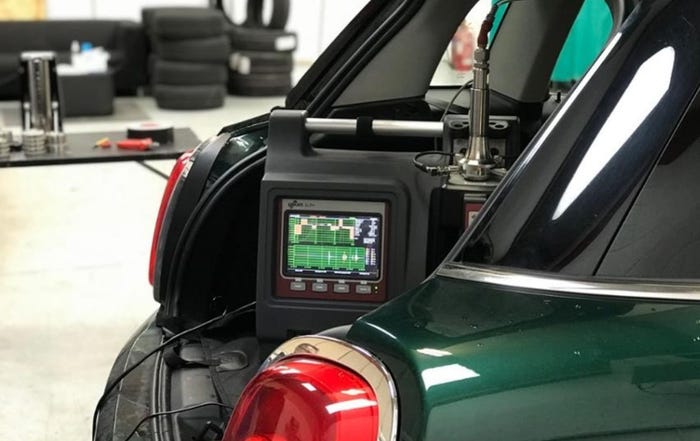Odyssey Could Get Electrified as Honda Looks to 2030 Bogey
The planned massive increase by Honda in sales of electrified vehicles has engineers and executives hammering out the details of which models will get the green treatment.
June 6, 2017

KONA, HI – Presently the only electrified minivan available in the U.S. is the Chrysler Pacifica Hybrid.
But Honda says the Odyssey also could get the hybrid treatment as the automaker wants to derive two-thirds of its global sales from electrified vehicles by 2030.
“We just released the hybrid (Acura) MDX so that powertrain could be considered in the future, although we can’t comment on particular plans,” Tom Sladek, principal engineer-Honda R&D Americas, tells WardsAuto in an interview here during an ’18 Odyssey media event.
The Odyssey and the MDX large CUV ride on the same unibody platform, known as 2SL, WardsAuto data shows.
The planned massive increase by Honda in sales of electrified vehicles (only 5% of the automaker’s sales last year were electrified models) has engineers and executives hammering out the details of which models will get the green treatment. Under the umbrella of electrified vehicles falls hybrids, plug-in hybrids, battery electric vehicles and fuel-cell EVs.
“The electrification initiative is definitely coming, but on which products and which timing is not 100% clear yet,” Sladek says.
The just-released Acura MDX Sport Hybrid pairs Acura’s 3-motor system from the RLX Hybrid sedan and NSX supercar to a 257-hp 3.0L SOHC port-injected V-6.
A large front motor is integrated into a 7-speed DCT and provides supplemental power and torque to the engine as well as converts engine power into electricity for the battery, while smaller rear motors provide all-wheel-drive capability, able to shift up to 100% of torque between back wheels. They also provide regenerative braking power to the battery.
As Acura has positioned the MDX Sport Hybrid as more sport than hybrid, the CUV’s combined fuel economy is a relatively low 27 mpg (8.7 L/100 km) and its total output a relatively high 321 hp.
For a hybrid minivan, Honda likely would tone down the latter figure and boost the former.
The Pacifica, a 2017 Wards 10 Best Engines winner and a PHEV marketed as a hybrid, has 260 net horsepower from a port-injected 3.6L Atkinson-cycle V-6 mated to two electric motors. After its lithium-ion battery pack’s 33-mile (53-km) charge is depleted, Chrysler says the Pacifica Hybrid can achieve an EPA-estimated 32 mpg (7.4 L/100 km). That compares with 22 mpg (10.7 L/100 km) combined in the non-hybrid Pacifica, which is solely propelled by a 3.6L V-6 without Atkinson cycle. The conventional Pacifica achieves 287 peak horsepower.
The Odyssey also has a combined fuel-economy rating of 22 mpg, but uses a 3.5L direct-injected V-6 making 280 hp.
With a 2025 U.S. CAFE fleet target of roughly 54.5 mpg (4.3 L/100 km) on the horizon for all automakers, Honda has employed 9- and 10-speed automatic transmissions on the new Odyssey, which has even Sladek in disbelief.
“If you would have told me a decade ago that when we were bringing out (a 6-speed automatic) that we would be at (a 10-speed AT) I would have been surprised. It’s hard to sort of predict where we’re going to go.
“2025 CAFE is challenging, especially on the bigger vehicles like this,” he continues. “You’re pushing a massive thing through the air and every gain you can get is super-important.”
The 10AT, a newly developed Honda transmission, is standard just on the top, most-feature-laden grades of the ’18 Odyssey, Touring and Elite, to offset their higher curb weights.
All other grades of the Odyssey use a ZF 9-speed automatic, also the transmission in the Pacifica.
Although Nissan uses CVTs on its light trucks in the U.S., Sladek says Honda sees a step-gear automatic as the best fit for a heavy model able to transport as many as eight passengers and that also may tow trailers. Honda prefers to reserve CVTs for its smaller, light models.
“In order to deliver that kind of quick response and make the car feel light, we feel like our step AT, especially the new 10AT, can really deliver that type of product that we want for the customer,” he says.
The sales potential of a hybrid minivan is unclear, given hybrids typically carry a price premium over conventional models and still lag their sales volume. Chrysler is not releasing expectations for the Pacifica Hybrid, although WardsAuto mid-year ’17 engine-installation data shows 4.3% of the roughly 95,000 minivans built through March were hybrids.
As the Pacifica Hybrid had a delayed sales launch, not going on sale until April 17 vs. previous timing of early 2017, it is likely the percentage of units built is low as the vehicle still is rolling out.
Some units of the Pacifica Hybrid were built in late 2016 and delivered in January, but quality and inventory-control issues, as well as a desire to launch sales near Earth Day, delayed deliveries, InsideEVs reports. Chrysler assuaged 700 customers on a wait list for the minivan with either a free Level 2 charging station or a $500 Visa gift card.
Meanwhile, Honda is prepping a dedicated hybrid for launch next year in the U.S. and later this year will debut its Clarity EV, following an early 2017 launch of the Clarity FCEV.
You May Also Like



